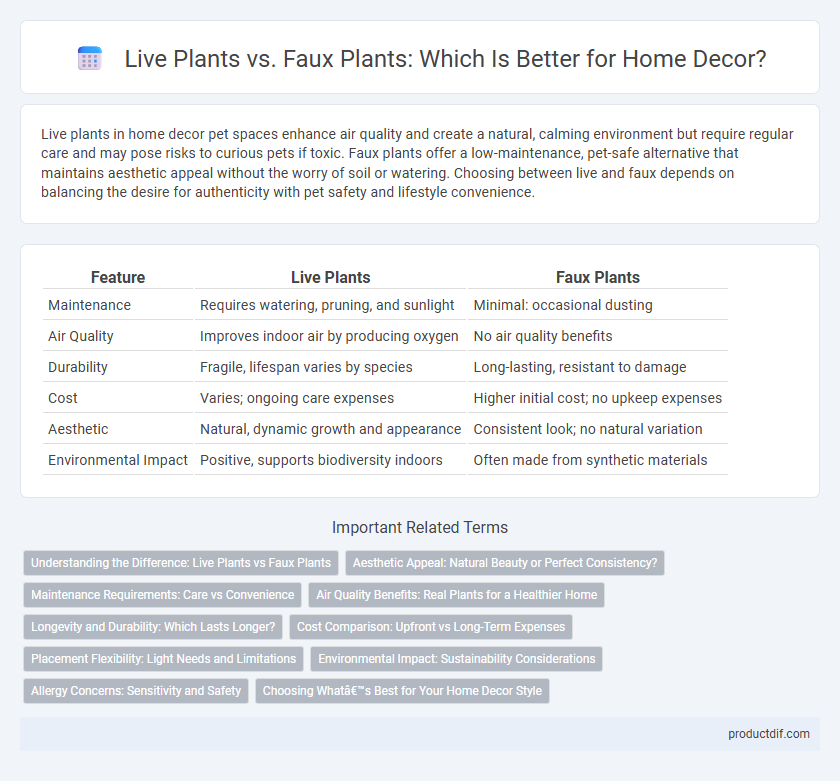Live plants in home decor pet spaces enhance air quality and create a natural, calming environment but require regular care and may pose risks to curious pets if toxic. Faux plants offer a low-maintenance, pet-safe alternative that maintains aesthetic appeal without the worry of soil or watering. Choosing between live and faux depends on balancing the desire for authenticity with pet safety and lifestyle convenience.
Table of Comparison
| Feature | Live Plants | Faux Plants |
|---|---|---|
| Maintenance | Requires watering, pruning, and sunlight | Minimal: occasional dusting |
| Air Quality | Improves indoor air by producing oxygen | No air quality benefits |
| Durability | Fragile, lifespan varies by species | Long-lasting, resistant to damage |
| Cost | Varies; ongoing care expenses | Higher initial cost; no upkeep expenses |
| Aesthetic | Natural, dynamic growth and appearance | Consistent look; no natural variation |
| Environmental Impact | Positive, supports biodiversity indoors | Often made from synthetic materials |
Understanding the Difference: Live Plants vs Faux Plants
Live plants enhance home decor with natural air-purifying qualities and dynamic growth, providing a fresh and organic ambiance. Faux plants offer low-maintenance alternatives with consistent appearance, perfect for spaces lacking natural light or busy lifestyles. Understanding the benefits and limitations of each helps in selecting the ideal greenery to complement interior design and personal care preferences.
Aesthetic Appeal: Natural Beauty or Perfect Consistency?
Live plants offer a dynamic aesthetic appeal with their natural textures, vibrant colors, and organic shapes that enhance indoor spaces with authentic beauty. Faux plants provide perfect consistency in appearance, maintaining flawless form and color year-round without the variability caused by growth or seasonal changes. Choosing between live and faux plants depends on whether the priority is a living, evolving ambiance or a low-maintenance, visually reliable decor element.
Maintenance Requirements: Care vs Convenience
Live plants require regular watering, appropriate sunlight, and occasional pruning to maintain their health and appearance, making them ideal for those who enjoy hands-on care and the natural benefits of green air purification. Faux plants offer a low-maintenance alternative, providing consistent aesthetic appeal without the need for watering, fertilizing, or concern about pest infestations, perfect for busy individuals or low-light spaces. Choosing between live and faux plants depends on balancing the desire for natural growth and air quality enhancement against the convenience of minimal upkeep.
Air Quality Benefits: Real Plants for a Healthier Home
Live plants improve indoor air quality by absorbing carbon dioxide and releasing oxygen through photosynthesis, creating a healthier living environment. They also filter harmful toxins and pollutants such as formaldehyde and benzene, which are commonly found in household products. Unlike faux plants, real plants contribute to natural humidity regulation, reducing the risk of respiratory issues and promoting overall well-being.
Longevity and Durability: Which Lasts Longer?
Live plants offer natural beauty and air-purifying benefits but require regular care and have a limited lifespan affected by environment and maintenance. Faux plants provide consistent appearance with minimal upkeep and resist fading or damage over time, making them a durable option for long-term decor. When considering longevity and durability, faux plants generally outlast live plants due to their resilience and low maintenance needs.
Cost Comparison: Upfront vs Long-Term Expenses
Live plants typically require a lower upfront investment but incur ongoing costs such as soil, fertilizers, and water, along with potential replacement expenses due to plant death. Faux plants have a higher initial cost but offer long-term savings as they require minimal maintenance, no watering, and last indefinitely without replacement. Evaluating cost-effectiveness depends on factors like maintenance effort, environmental conditions, and personal preferences for authenticity versus convenience.
Placement Flexibility: Light Needs and Limitations
Live plants require specific light conditions, often needing natural sunlight or grow lights to thrive, which limits their placement in dim or windowless areas. Faux plants offer superior placement flexibility since they do not depend on light, making them ideal for rooms with low or no natural light. Choosing between live and faux plants hinges on the availability of suitable lighting and the desired maintenance level in your home decor.
Environmental Impact: Sustainability Considerations
Live plants improve indoor air quality and contribute to a healthier environment by absorbing carbon dioxide and releasing oxygen, making them a sustainable choice for home decor. Faux plants, often made from non-biodegradable plastics and synthetic materials, contribute to environmental pollution and waste, lacking the natural lifecycle benefits of live greenery. Choosing live plants supports biodiversity and reduces plastic consumption, aligning with eco-friendly living and sustainability goals.
Allergy Concerns: Sensitivity and Safety
Live plants improve indoor air quality by naturally filtering allergens and pollutants, yet certain species can trigger reactions in sensitive individuals due to pollen or mold growth. Faux plants eliminate the risk of allergies and require minimal maintenance but may accumulate dust, which can also cause irritation if not regularly cleaned. Choosing hypoallergenic live plants like snake plants or opting for high-quality, dust-resistant faux plants enhances safety for allergy sufferers.
Choosing What’s Best for Your Home Decor Style
Live plants bring natural texture, vibrant colors, and air-purifying benefits that complement organic or bohemian home decor styles. Faux plants offer low-maintenance, long-lasting greenery ideal for modern or minimalist spaces where maintaining live plants may be challenging. Selecting between live and faux depends on your lifestyle, lighting conditions, and desired ambiance to enhance your home's aesthetic seamlessly.
Live Plants vs Faux Plants Infographic

 productdif.com
productdif.com